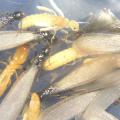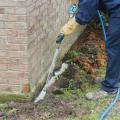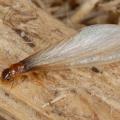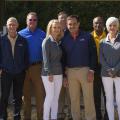Species of Termites in Mississippi
Three major species of termites occur in Mississippi: eastern subterranean termites, Formosan termites, and southeastern drywood termites. All three species damage buildings, but their distribution varies within the state. Eastern subterranean termite is a native species that occurs throughout Mississippi, as well as through much of the eastern United States. Formosan termites are not native to the United States, but now occur in portions of 25 Mississippi counties and are continuing to spread. Southeastern drywood termites are also native but have the most restricted distribution; they regularly occur only in the three coastal counties.
Eastern subterranean termites, Reticulitermes flavipes
This is our most common termite. Eastern subterranean termites (Figure 1) infest and damage buildings in all Mississippi counties. They are also a natural part of our forest ecosystem, in both pines and hardwoods, where they play an important role in recycling dead trees and limbs. As long as they remain outside in the woods and landscape, termites are beneficial. It is only when they invade our buildings that they become pests.
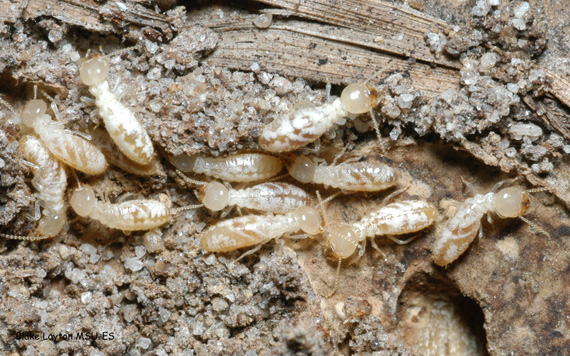
Eastern subterranean termite swarmers (Figure 2) are about 3/8 inch long, including the wings; the wings are white or translucent and their bodies are dark brown to black. Swarming usually occurs in the morning, and most swarms occur in the spring, though timing varies considerably depending on location. In the coastal counties, swarms may occur as early as late January with peak swarming activity in late February to early April, but swarming usually occurs from April through June in northernmost counties. Eastern subterranean termites occasionally swarm in the fall, but most swarming occurs in the spring.
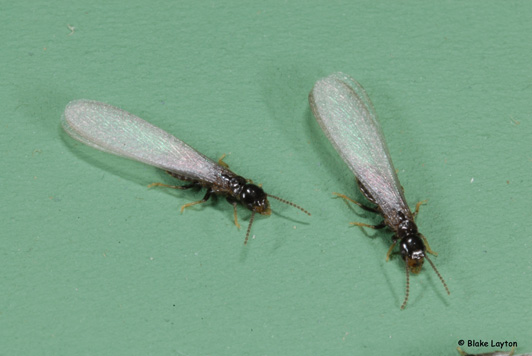
Eastern subterranean termite soldiers (Figure 3) can be identified by their large, rectangular heads and heavy, curved mandibles. Soldiers are less numerous than workers, with a ratio of roughly one soldier per 50 workers.
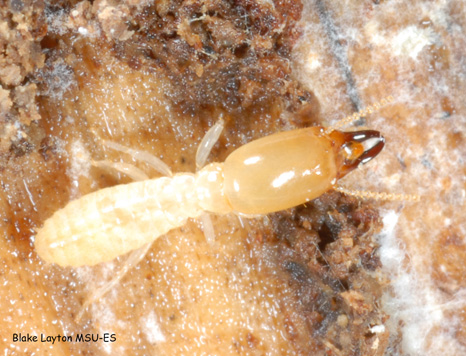
Other Reticulitermes species.
Several other species of Reticulitermes termites occur in the state, but these are less common and their biology and control is similar to that of eastern subterranean termites. These include dark southern subterranean termites, R. virginicus, which are slightly smaller than eastern subterranean termites, and light southern subterranean termites, R. hageni. Light southern subterranean termites usually swarm in the fall and their swarmers are light brown, which can cause them to be mistaken for Formosan termites, although they are smaller than Formosan swarmers.
Formosan termites, Coptotermes formosanus
Formosan termites are non-native termites that were first detected in the state in 1984. Since then they have spread to 26 of Mississippi’s 82 counties (Figure 4) and continue to slowly expand their range. Initial introduction into the state was attributed to the use of infested railroad crossties imported from other states as landscape timbers (Figure 5). Although Formosan termites spread short distances by swarming, movement of infested wood products can easily result in rapid transportation and introduction of these damaging termites into other areas of the state. Because of this threat, the Mississippi Department of Agriculture enforces a quarantine against movement of wood or wood products that have been in direct contact with the soil. Since it was initiated, this quarantine has slowed the spread of Formosan termites within the state.

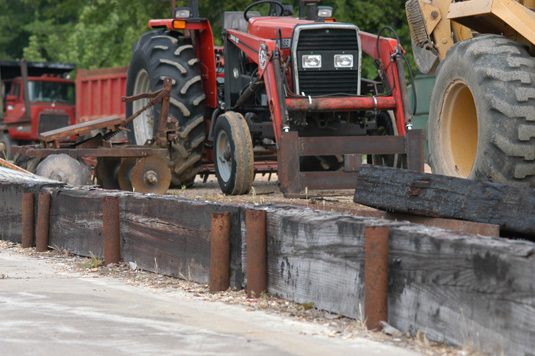
Although Formosan termite workers look very similar to the workers of eastern subterranean termites (Figure 6), the swarmers and soldiers are easy to distinguish. Formosan termite swarmers (Figure 7) are about ½ inch long, including the wings, and are tan to light brown. In the southern portion of the state, Formosan termites usually swarm in late April through mid-May, usually within a week or so of Mother’s Day, but swarming is delayed into June in the central part of the state. Swarming occurs at night, usually at or shortly after dusk, and swarmers are strongly attracted to lights. In heavily infested areas, the number of swarmers coming to lights can be so large that they become a serious nuisance, resulting in delays of athletic activities, music events, and other outdoor nighttime activities. Fortunately, swarm season lasts only a few weeks.
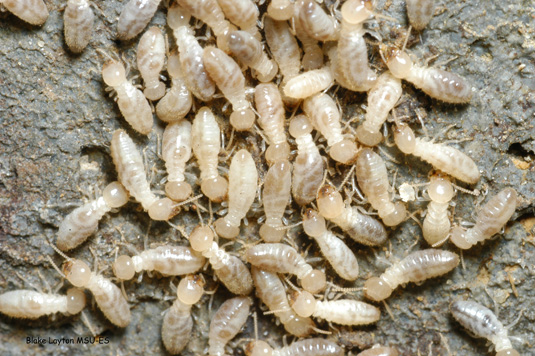
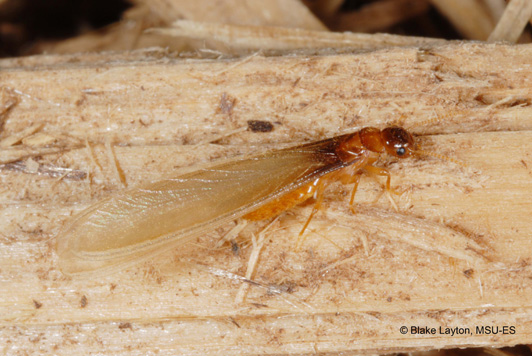
In contrast to the rectangular head of eastern subterranean termites, Formosan termite soldiers (Figure 8) have a teardrop-shaped-head, with large, stout mandibles. Formosan termite colonies also have a relatively large number of soldiers, roughly one soldier for every ten workers. If you encounter a colony of termites that seems to have a relatively high number of soldiers, there is a good chance they are Formosan termites. Finding and collecting soldiers is one of the easiest and surest methods of identifying Formosan termites.
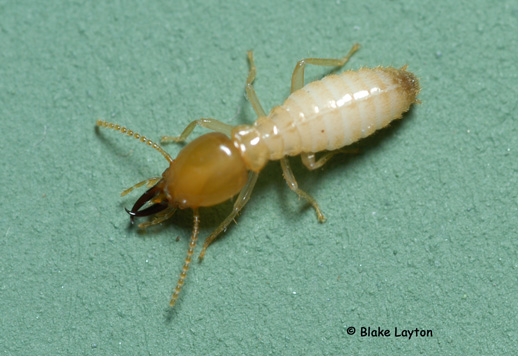
Formosan termites are similar to eastern subterranean termites in general biology and behavior. However, they tend to be more aggressive in invading buildings, and they can do more damage in a shorter period of time. Fortunately, treatments used to control eastern subterranean termites are also effective against Formosan termites. The major difference in Formosan termite control is in the need to detect and treat any aerial nests.
Although Formosan termites are a “subterranean termite,” meaning that they nest and forage primarily in the soil just like eastern subterranean termites, they are much more likely to establish aerial nests, especially if they have a ready source of aboveground moisture due to water leaks. These aerial nests are composed of a hardened material called carton (Figure 9) made from saliva, feces, and chewed wood particles, and this carton material can absorb moisture from humid air to help provide water for the colony. This is significant because once termites establish an aerial nest, (Figure 10) they no longer have to return to the soil to obtain moisture and can become separate and independent from the mother colony. Such aerial nests will not be controlled by in-ground bait stations or soil-applied liquid termiticide treatments and must be controlled with specially targeted insecticide foam treatments or other aboveground treatment methods.
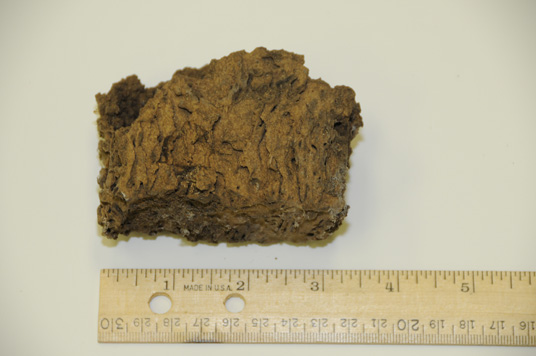
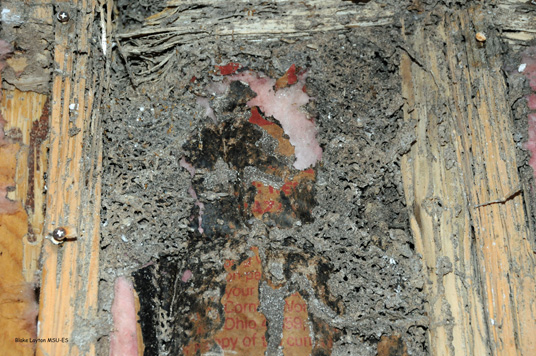
Note that initial infestation of a building by Formosan termites usually occurs as a result of foraging workers entering the structure through the ground and establishing foraging tunnels (Figure 11) into the building, just as with eastern subterranean termites. This is why soil-applied insecticide treatments (Figure 12) and in-ground bait stations (Figure 13) are the primary treatments for preventive control of Formosan termites. Although such treatments will not control aerial colonies, they are effective for preventing initial infestations. In most cases, aerial nests only become established when termites foraging back and forth from the soil encounter an aboveground source of moisture and then establish an aerial nest, which can eventually grow to become independent of the parent colony and survive without the need to obtain moisture from the ground.
However, in some situations, Formosan termite swarmers are able to establish aerial colonies directly in above-ground wood that is moist due to structural or plumbing leaks, or in other above-ground situations, such as roof-top planter boxes or accumulations of decomposing leaves. Aerial infestations of Formosan termites can even occur on roof tops of multi-story buildings.
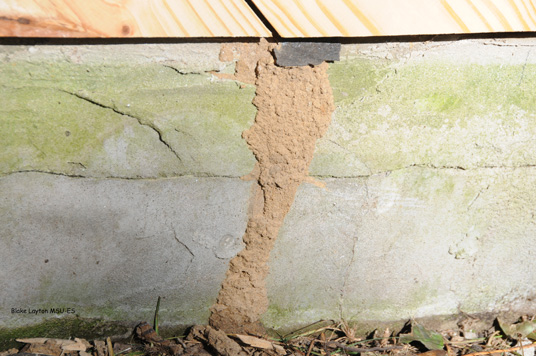
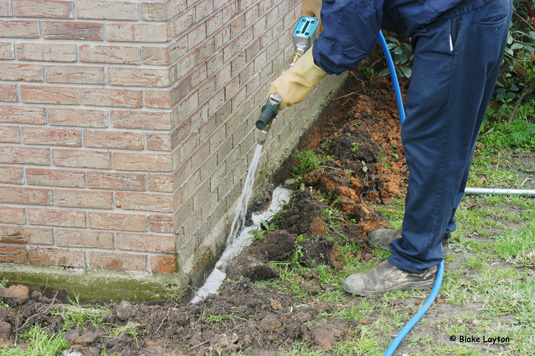
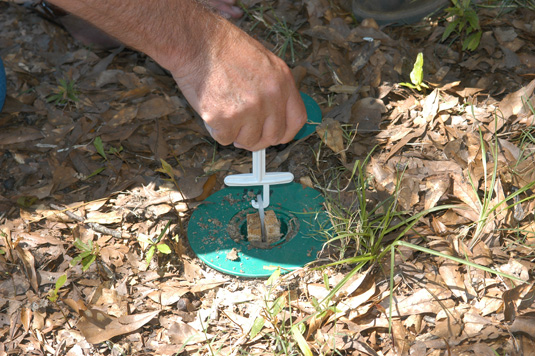
Southeastern drywood termites, Incisitermes snyderi
Drywood termites only occur along the Mississippi Gulf Coast, where they infest wood in dead trees as well as buildings and pieces of furniture. These are not subterranean termites. As the name implies, colonies are established directly in dry wood and there is no contact with the soil. Drywood termites are able to obtain the water they need from humid air and the wood on which they are feeding.
Infestations of drywood termites are relatively uncommon, even on the Mississippi Gulf Coast, and drywood termite colonies are much smaller than those of subterranean termites. Infestations of drywood termites may be limited to only a single piece of wood, a few pieces of wood in a small area of the house, or a single piece of furniture. However, colonies that have been established for many years can spread into many areas of a building, making control more difficult.
Southeastern drywood termite swarmers (Figure 14) are superficially similar to Formosan termite swarmers, both in general appearance and the time of year when swarms occur. Southeastern drywood termites normally swarm in May and June, with most swarms occurring at dusk. Swarmers are yellow to light brown and about 7/16 inches long, including the wings. However, in southeastern drywood termite swarmers the head is usually the same color as the middle part of the body, the head and body appear smooth and shiny, and the wings appear clear. Formosan termite swarmers usually have heads that are darker than the middle part of the body and the body appears less smooth and the wings less clear due to the presence of large numbers of small dark hairs on both the wings and body (these are very small and can only be seen through a good microscope.) If you are not sure which species of termite you have, collect some swarmers, preserve them in ethyl alcohol, and send them in to the MSU Extension Insect Identification Lab for identification.
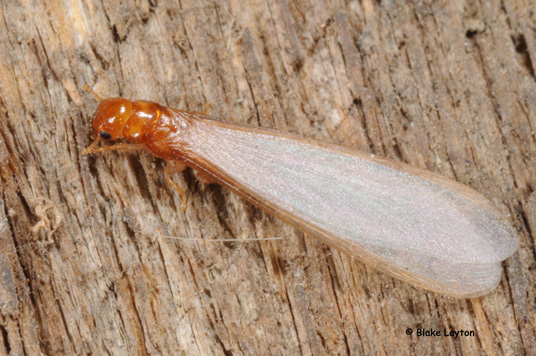
Southeastern drywood termite soldiers have large, rectangular heads and extremely stout, dark mandibles with smaller, irregular teeth along the inner margins of both mandibles. Soldiers of Formosan and eastern subterranean termites do not have these small teeth and the inner margin of their mandibles is smooth.
Accumulations of dry fecal pellets (Figure 15) is a key sign and identifying trait of drywood termites. Workers push the dry, six-sided fecal pellets out of the galleries and these can accumulate in small piles where they may be noticed by homeowners. Pellet color varies from light to dark, depending on the type of wood on which they are feeding, but the presence of fecal pellets is a sure sign of drywood termite infestation. Do not mistake cockroach droppings (Figure 16) for drywood termite fecal pellets (Figure 17). Both can appear 6-sided, but cockroach fecal pellets vary in size and shape while termite pellets are uniform in size.
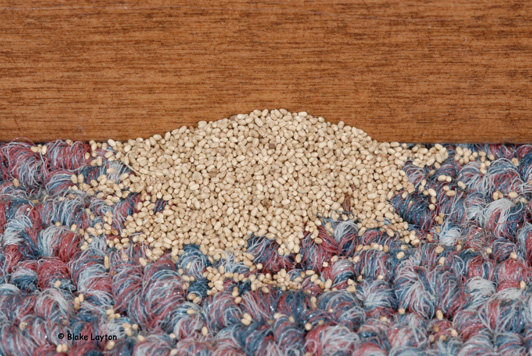
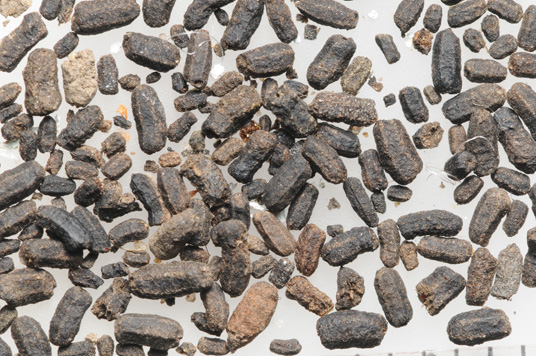
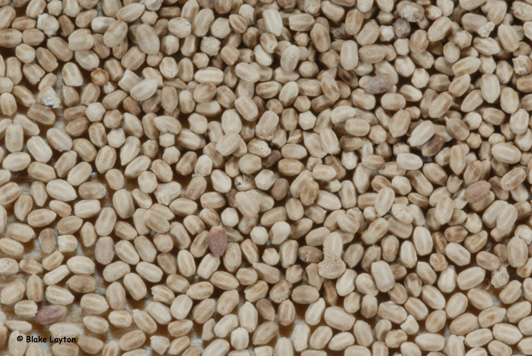
Control of drywood termites is much different than control of subterranean termites. If infestations are detected early when colonies are small, removal and destruction of the few pieces of infested wood may be all that is required. However, in the case of a heavy infestation that has spread throughout the building, it may be necessary to tent and fumigate the entire building. Other treatment options include treatment of infested wood with borate-based treatments or the use of dry granular baits, which are introduced into active galleries. In the case of infested furniture, having the piece “chamber fumigated” is another option. Exposing infested items to low or high temperatures, such as freezing or kiln drying, can also be used to control drywood termites, but care must be taken to be sure such treatments will not damage the item being treated.
Other drywood termite species
Several other non-native species of drywood termites occasionally occur in the state as a result of being imported in infested furniture, wood carvings or wood bowls. Such infestations are rare, but can occur anywhere in the state. So far, none of these species have become established in the state, but, when not detected for some time, it is possible for drywood termites to move from the initial piece of infested wood or furniture into other wood in the building. For example, in one case, drywood termites moved from a wooden bowl that was purchased overseas into a large built-in bookcase on which the bowl was being displayed. In another case, West Indian drywood termites spread, by swarming, from a large piece of imported furniture to other pieces of antique furniture and to several locations in built-in cabinets, resulting in a heavy infestation that could only be treated by tenting and fumigating the building.
Western drywood termites, Incisitermes minor, are the most frequently encountered “other drywood species.” (Figure 18) This termite is native to portions of the western United States and has become established in portions of Florida, as well as New Orleans. Infestations in Mississippi are rare and are usually associated with the movement of infested furniture. West Indian drywood termite, Cryptotermes brevis, is another species that is occasionally encountered in the state. Again, initial introduction usually occurs by importing infested furniture, but infestations can spread to other areas of the building as a result of swarms.
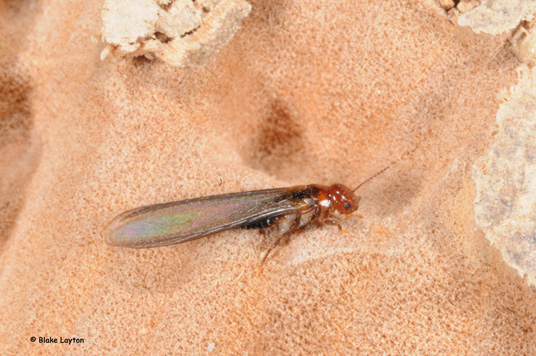
Dr. Blake Layton, Extension Entomology Specialist
Department of Entomology, Mississippi State University
Phone: 662-325-2960
Email: blake.layton@msstate.edu
Publications
News
Mississippi’s native subterranean termites have started swarming, and these structure-destroying insects will continue to swarm across the state over the next few months.
John Riggins, professor of forest entomology in the Mississippi State University Department of Agricultural Science and Plant Protection, said termites swarm to produce new colonies when the weather warms up, often after a rain.
Termites exist all over Mississippi and will eventually infest and damage any structure that contains wood or other cellulose components unless you properly protect those structures.
Invasive Formosan subterranean termites were first found in the state 40 years ago, and soon, these dangerous pests will swarm and threaten unprotected structures in about one-third of Mississippi’s counties.
Santos Portugal, Mississippi State University Extension Service urban entomologist, said Formosan termites typically swarm in the millions from early May to early June. They have the ability to infest and significantly damage structures much more quickly than native subterranean termites.
Success Stories
A dream of the Mississippi Pest Control Association and the Mississippi State University Extension Service is coming true after more than 20 years, thanks to a generous donation by one of Mississippi’s oldest pest-control companies.

